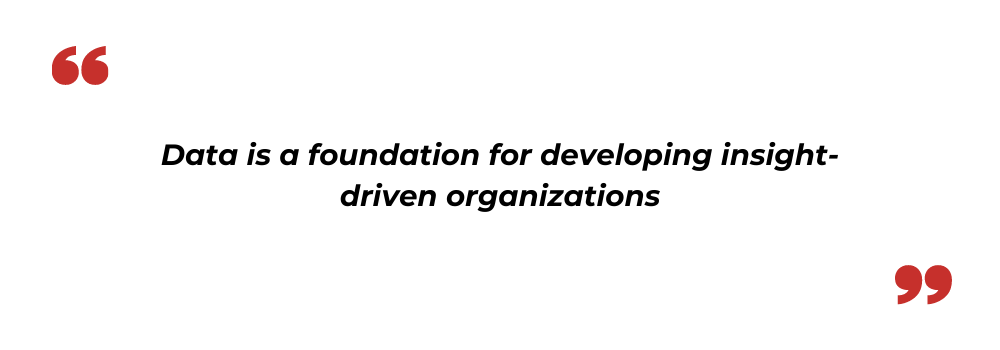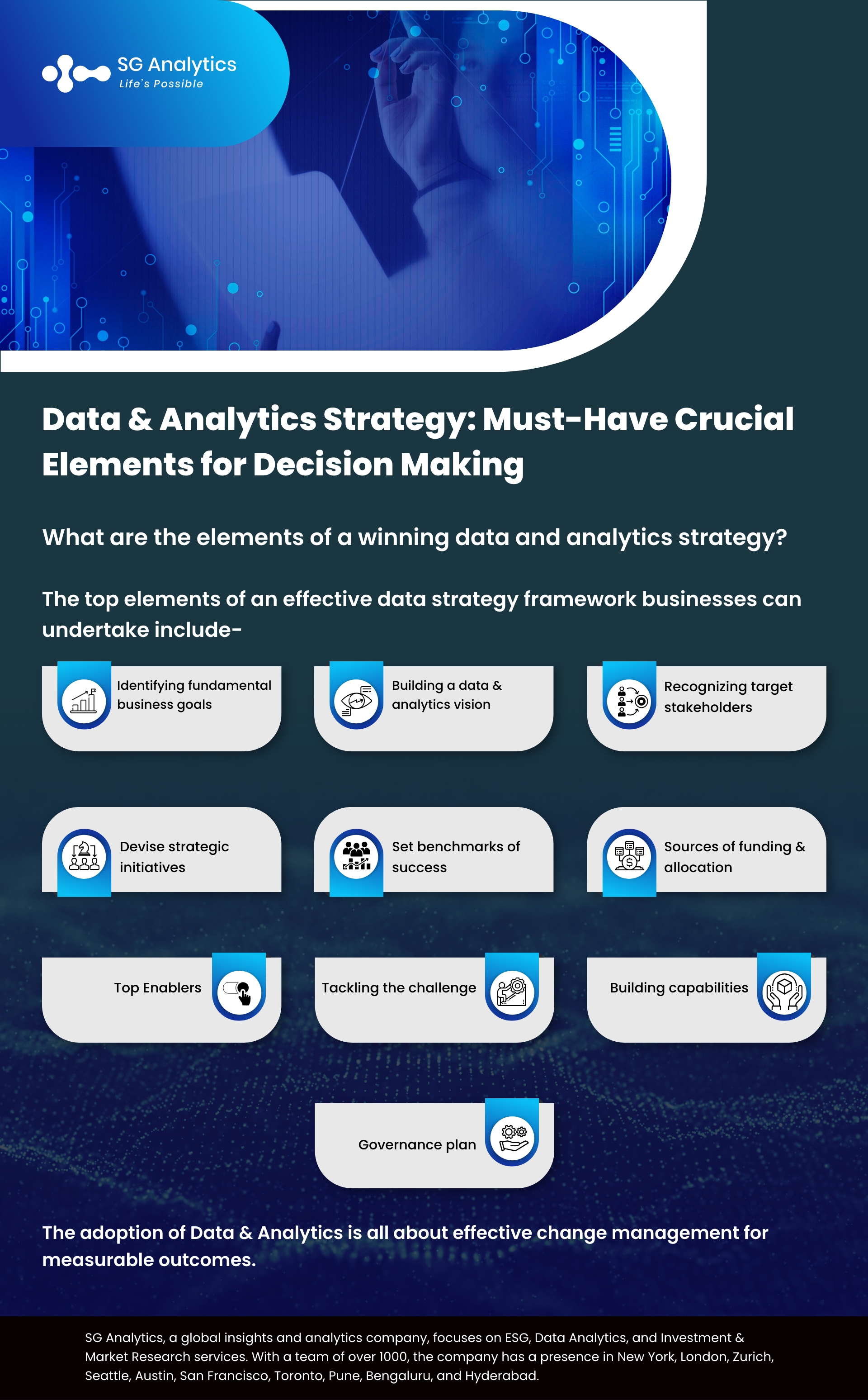Organizations globally are leveraging data and analytics (D&A) for enhanced business performance. Today, data-driven organizations are 23 times more likely to acquire customers and six times as likely to retain customers as per the report shared by the McKinsey Global Institute survey. Many companies, despite being data-rich, are deficient in deriving insights. One major reason for the poor success rate of D&A strategy implementation is the lack of stakeholder buy-in, i.e., poor user adoption.
When the organizational data and analytics (D&A) efforts do not align with the organization’s business goals, the big-ticket investments and actions go down the drain and hamper the business momentum. Organizations venturing into D&A without any data strategy often end up with results that are equally disastrous.

How can enterprises improve their adoption of D&A and deliver results?
Quite like AI and Big Data, data strategy is a buzzword currently making rounds in the industry. A data strategy is an organizational plan devised to achieve one or more long-term goals under uncertainty. Similarly, it is a plan with a set framework that helps achieve business goals. Data strategy assists in better decision-making by incorporating data.
What are the elements of a winning data and analytics strategy?
Below are the top key elements of an effective data strategy framework businesses can undertake to increase their adoption of D&A to improve business performance.
Read more: A Brave New World – Fascinating Real-Life Applications of Data Analytics

-
Identifying Fundamental Business Goals
A data strategy is a framework crafted in service of long-term business goals. There has to be absolute clarity on the organizational vision and key priorities. Business goals are aimed to transform lives and offer life-changing solutions to people. To review and internalize the organizational strategy, business leaders should be aware of “what the long-term business goals are?”
-
Building a Data & Analytics Vision
Once the business goals are internalized, finding how data and analytics can help achieve them is the next step. This vision for data strategy helps in guiding the choices of the stakeholders as well as the selection of initiatives and validating the intended outcomes. It helps focus on finding solutions to big queries that can later advance and impact organizational decisions.

-
Recognizing Target Stakeholders
While determining business objectives, it is vital to be aware of whom the organization wants to foster through the data initiatives? While it is compelling to serve everyone, this is not a realistic scenario. By picking a set of target departments and roles, business leaders can plan and accelerate development to achieve targeted business growth.
-
Devise Strategic Initiatives
Once the industry leaders have determined their destination for achieving target growth, it is time to explore big initiatives that will assist them in getting closer to their goals. By incorporating strategic programs, leaders can help the chosen stakeholders to achieve their business objectives. It is vital to start with the question that the leaders are trying to answer and then work back to identifying and implementing those solutions.

-
Set Benchmarks of Success
For every strategic initiative, it is critical to question - what will succeed in the set initiatives look like? Leaders or stakeholders often pick initiatives based on the urgent requirement rather than the impact it is likely to create. By documenting the desired outcomes, leaders can validate whether the chosen initiatives were the most influential. By setting key performance indicators (KPIs) and objectives & key results (OKRs), business leaders can track their progress with their business goals.

-
Sources of Funding & Allocation
After gaining clarity on the initiatives and their desires outcomes, the next step is to recognize and identify - who will foot the accounts for these programs? Often organizations construct big strategic plans but shortly realize the unavailability of sources of funding to secure the needed initiatives. To tackle these crises, some firms assign a fixed percentage of their departmental budget to the D&A initiatives, while others allocate a portion of their centralized technology spending for these agendas.
Read more: Data-Centricity: The New Roadmap to Driving Enterprises in a Changing World
-
Top Enablers
While strategic plans are easy to make, they are tough to execute. For industry leaders to manage this successfully, they must be aware of the strategic ways to support the efforts. It is critical for them to spot tailwinds within the organization and capitalize on them over the long run. While an innovation-friendly culture might see lower resistance to user adoption, leaders should build a good strategy that helps in answering the why, what, and how questions raised by the employees.
-
Tackling the Challenges
Tech-savvy leaders should identify the tailwinds, as well as watch out for the likely headwinds. Identifying the biggest roadblocks will help in planning ways to mitigate them. Articulating the backing needed with the organizational data strategy is an immaculate way to ensure the necessary resources. While organizations may vary in the sophistication and maturity of tech implementation, this holds power to hamper rollouts. Hence it is vital for leaders to factor in those roadblocks while planning initiatives.

-
Building Capabilities
While incorporating the data and analytics strategy, industry leaders must invest in capabilities across people, processes, and technology. This is vital for building a data strategy execution muscle. To integrate the D&A initiatives, it is vital for employees to be aware of the following-
-
How to onboard users?
-
How to rewire business processes?
-
How to strategize a technology strategy that bears the D&A fruits?
Organizations should make a critical investment in building competencies among employees, adopting new tools, and helping their teams to keep an open mind to experiment.
-
Governance Plan
To ensure that the data & analytics strategy is implemented throughout the year, leaders must build mechanisms to track and review the outcomes from D&A. It is vital to plan and review the progress not just of business projects but also of tech initiatives, including platform upgrades and upskilling. Organizations should set up a steering committee to review the progress of programs as well as validate outcomes.

Data Strategy: What Problem Does It Solve?
An effective application of a data strategy within an organization helps in aligning the organization's vision with a single goal or a single set of guiding behaviors. A vital part of the strategy is to define the target state. This helps to set the background for where an organization wants to end up once they have implemented the data strategy. The strategy should be reworked over the course of a few years as things change at a faster pace in the world of data. In addition, the strategy should also include capabilities for:
-
Technical
-
Process
-
People
-
Architectural components
The strategic vision should align with and be supportive of the broader organizational vision, mission, and goals.
Progressive data and analytics (D&A) leaders are diverting the discussion away from tools and technology and aiming it toward decision-making to enhance business competency. While this evolution will take time, the D&A leaders are already in the best position to help direct and lead this change.
Read more: The Science of Music: How Big Data Is Transforming the Music Industry?

How to Execute an Effective Data Strategy Framework?
Business leaders or executives play a crucial role in the crafting and culmination of an organization’s data strategy. Leaders are now striving to define the most vital business problems to solve and set measurable goals for the D&A strategy. To cultivate an environment that aligns with strategic decision-making, industry leaders are leading by example and demonstrating data used to make critical decisions.
While bringing in a cultural shift with data is the need of the hour, it is easier said than done. Data science helps organizations in seeing the possibilities and the potential for impact. An effective data and analytics strategy is likely to pave the way for meaningful execution.
The adoption of D&A is all about effective change management for measurable outcomes. Adoption strategies should focus on the audience as well as the way business stakeholders employ data, algorithms, and assumptions to derive insights and business objectives.
With the world advancing towards a digital and data-centric economy, the right D&A strategy will help transform data into a business asset by offering the desired insights for sound decision-making.
With a presence in New York, San Francisco, Austin, Seattle, Toronto, London, Zurich, Pune, Bengaluru, and Hyderabad, SG Analytics, a pioneer in Research and Analytics, offers tailor-made services to enterprises worldwide.
A leader in Data Analytics, SG Analytics focuses on leveraging data management & analytics and data science to help businesses discover new insights and build strategies for business growth. Contact us today if you are looking to make critical data-driven decisions to prompt accelerated growth and breakthrough performance.









